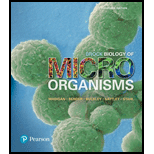
Concept explainers
The genome of the bacterium Neisseria gonorrhoeae consists of one double-stranded DNA molecule that contains 2220 kilobase pairs. If 85% of this DNA molecule is made up of the open reading frames of genes encoding proteins, and the average protein is 300 amino acids long, how many protein-encoding genes does Neisseria have? What kind of genetic information is present in the other 15% of the DNA?
To discuss:
The Neisseria gonorrhoeae bacterial genome consists of one double stranded DNA and that contains 2220 Kbp. If 85% of this DNA sequence is made up of open reading frames of genes encoding proteins, and the average protein size is 300 amino acids long, Neisseria contains how many protein-encoding genes. Other 15% of the DNA sequence contains what kind of genetic information.
Concept introduction:
Open reading frames or ORF is a specific segment of DNA or RNA molecule and that part can be translated into a protein sequence. An open reading frame (ORF) (sequence of nucleotides) contains a start codon (AUG) followed by a stretch of various codons and end with a stop codon (UAA, UGA, or UAG). An ORF region in the mRNA is essential for its translation.
Explanation of Solution
The Neisseria gonorrhoeae bacterial genome contains 2220 Kbp or 2,220,000 bp.
Each base pair size is 0.34 nm.
Therefore 2220 Kbp x 0.34 nm is 754, 800 nm.
The length of DNA is 754, 800 nm or 0.07548 cm
If 85% of the bacterial genome is composed of open reading frames, 1,887 Kbp of DNA sequence could be the open reading frames.
(
Average size of the protein is 300 amino acids. Each amino acid is encoded by three nucleotides (one codon). Therefore, 900 bp of DNA sequence in the open reading frame encode proteins.
Number of protein coding bacterial gene is 2097. The remaining 15 % of the bacterial DNA can be non-coding genes, which may regulate gene expression.
Want to see more full solutions like this?
Chapter 4 Solutions
Brock Biology of Microorganisms (15th Edition)
- Describe three cranial and postcranial features of Neanderthals skeletons that are likely adaptation to the cold climates of Upper Pleistocene Europe and explain how they are adaptations to a cold climate.arrow_forwardBiology Questionarrow_forward✓ Details Draw a protein that is embedded in a membrane (a transmembrane protein), label the lipid bilayer and the protein. Identify the areas of the lipid bilayer that are hydrophobic and hydrophilic. Draw a membrane with two transporters: a proton pump transporter that uses ATP to generate a proton gradient, and a second transporter that moves glucose by secondary active transport (cartoon-like is ok). It will be important to show protons moving in the correct direction, and that the transporter that is powered by secondary active transport is logically related to the proton pump.arrow_forward
- drawing chemical structure of ATP. please draw in and label whats asked. Thank you.arrow_forwardOutline the negative feedback loop that allows us to maintain a healthy water concentration in our blood. You may use diagram if you wisharrow_forwardGive examples of fat soluble and non-fat soluble hormonesarrow_forward
- Just click view full document and register so you can see the whole document. how do i access this. following from the previous question; https://www.bartleby.com/questions-and-answers/hi-hi-with-this-unit-assessment-psy4406-tp4-report-assessment-material-case-stydu-ms-alecia-moore.-o/5e09906a-5101-4297-a8f7-49449b0bb5a7. on Google this image comes up and i have signed/ payed for the service and unable to access the full document. are you able to copy and past to this response. please see the screenshot from google page. unfortunality its not allowing me attch the image can you please show me the mathmetic calculation/ workout for the reult sectionarrow_forwardIn tabular form, differentiate between reversible and irreversible cell injury.arrow_forwardhelparrow_forward
- Can you please help me answer these questions?arrow_forwardSkryf n kortkuns van die Egyptians pyramids vertel ñ story. Maximum 500 woordearrow_forward1.)What cross will result in half homozygous dominant offspring and half heterozygous offspring? 2.) What cross will result in all heterozygous offspring?arrow_forward
 Human Heredity: Principles and Issues (MindTap Co...BiologyISBN:9781305251052Author:Michael CummingsPublisher:Cengage Learning
Human Heredity: Principles and Issues (MindTap Co...BiologyISBN:9781305251052Author:Michael CummingsPublisher:Cengage Learning Biology: The Dynamic Science (MindTap Course List)BiologyISBN:9781305389892Author:Peter J. Russell, Paul E. Hertz, Beverly McMillanPublisher:Cengage Learning
Biology: The Dynamic Science (MindTap Course List)BiologyISBN:9781305389892Author:Peter J. Russell, Paul E. Hertz, Beverly McMillanPublisher:Cengage Learning Biology (MindTap Course List)BiologyISBN:9781337392938Author:Eldra Solomon, Charles Martin, Diana W. Martin, Linda R. BergPublisher:Cengage Learning
Biology (MindTap Course List)BiologyISBN:9781337392938Author:Eldra Solomon, Charles Martin, Diana W. Martin, Linda R. BergPublisher:Cengage Learning Biology Today and Tomorrow without Physiology (Mi...BiologyISBN:9781305117396Author:Cecie Starr, Christine Evers, Lisa StarrPublisher:Cengage Learning
Biology Today and Tomorrow without Physiology (Mi...BiologyISBN:9781305117396Author:Cecie Starr, Christine Evers, Lisa StarrPublisher:Cengage Learning Human Biology (MindTap Course List)BiologyISBN:9781305112100Author:Cecie Starr, Beverly McMillanPublisher:Cengage Learning
Human Biology (MindTap Course List)BiologyISBN:9781305112100Author:Cecie Starr, Beverly McMillanPublisher:Cengage Learning Biology 2eBiologyISBN:9781947172517Author:Matthew Douglas, Jung Choi, Mary Ann ClarkPublisher:OpenStax
Biology 2eBiologyISBN:9781947172517Author:Matthew Douglas, Jung Choi, Mary Ann ClarkPublisher:OpenStax





